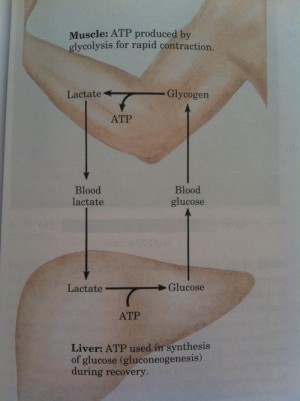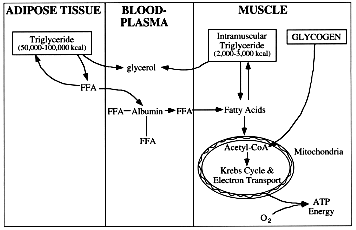Why you need to fuel up for a long run
I’ve spoken on this blog before about why you need to fuel up for a long run, but never really discussed WHY it is so important.
To get us started, I want to show you a video of someone who has run out of fuel. This is called ‘hitting the wall’.
Every time I watch this video, it makes me feel sick. Horrifying to watch.
So, what’s the process?
Firstly, you need food to power your muscles so you can run. To keep it simple, you eat your gel, or your porridge or toast, and it is digested to glucose.  As you can see from the diagram (from Lehninger Principles of Biochemistry, 4th edition p899), this then moves to the muscle to be stored as glycogen, and then converted to a substance called ATP which is what your muscles use for energy so they can contract. The time it takes for the food you’ve eaten to digest depends on the glycaemic index and type of carbohydrate. For example, a gel is available for use within minutes due to a special combination of carbohydrate to improve absorption, and a high GI level, whereas your porridge will take much longer to digest. As discussed in a previous post, fat is also used to fuel you on your long runs. The better trained you are, the better your body is at using fat for fuel.
As you can see from the diagram (from Lehninger Principles of Biochemistry, 4th edition p899), this then moves to the muscle to be stored as glycogen, and then converted to a substance called ATP which is what your muscles use for energy so they can contract. The time it takes for the food you’ve eaten to digest depends on the glycaemic index and type of carbohydrate. For example, a gel is available for use within minutes due to a special combination of carbohydrate to improve absorption, and a high GI level, whereas your porridge will take much longer to digest. As discussed in a previous post, fat is also used to fuel you on your long runs. The better trained you are, the better your body is at using fat for fuel.
Whilst the pool of storage of fat in the average human is quite large (for example in an elite athlete, this may only be approximately 5kg, which is much less than the ‘average Joe’), the pool of stored carbohydrate is limited, which is why we recommend to consume carbohydrate during endurance activity, with current recommendations being to consume 30g of carbohydrate approximately every 40 minutes, though there is research which indicates that if more is tolerated, up to 90g per hour can improve performance.
 As can be seen from the second diagram (from GSSI web), glucose (glycogen) is required for fat oxidation. Thus, carbohydrate is the rate limiting fuel. If this runs out, you do not have enough fuel to continue, and you hit the wall.
As can be seen from the second diagram (from GSSI web), glucose (glycogen) is required for fat oxidation. Thus, carbohydrate is the rate limiting fuel. If this runs out, you do not have enough fuel to continue, and you hit the wall.
Though it is an extreme case, as you can see from the initial video, Paula was unable to run properly initially, then walking became difficult. Eventually, she was unable to stand. Hitting the wall affects all parts of the body. Specific ‘symptoms’ are general weakness, fatigue, low blood sugar levels and in some instances hallucinations. Dopamine levels also start to drop, which essentially helps your brain tell you that you need to stop. If you have done any long distance running, it is likely you have hit the wall to some extent in training before, be it simply feeling like you can’t keep going, a heaviness in your legs and like ‘you’re out of energy’. These feelings are then improved by eating something, and best case scenario, they disappear. Worst case scenario, the problems get progressively worse, as shown in the video.
If you do not consume carbohydrate when running for more than an hour, your performance will steadily decrease as you hit the wall. If you have not eaten your carbohydrate rich meal prior to the run, this will happen a lot sooner. If you are the type of person who struggles to eat early, at least getting some liquid (such as a sports drink) in is required, and it is likely you will need to eat more during the run to keep your glucose levels up. Furthermore, part of training is training your body to accept carbohydrates before you run; this is an integral part of training and should not be skimped on.
Hydration is the other imperative aspect here. Dehydration is a major cause of poor sports performance. More than 2% dehydration can impair performance. The science speaks for itself here; running speed is reduced by 6-7% with 2% decrease in body fluid. A 1% reduction in fluid can add approximately 17 seconds extra to 1500m run. Heat and humidity can also affect the body’s ability to cool itself. 70% of body heat is lost when water evaporates; in humid conditions, this does not work as effectively. In hot conditions, we sweat more in an effort to cool our body’s down, which results in needing more fluid. If the body over heats, you can start to feel dizzy, nausea, cramps, headache, reduced sweating (due to lack of fluid availability) and hot, dry skin.
In most (elite) cases the rates of sweat loss is higher than the rate of fluid intake. This can lead to a fluid deficit which ultimately increases the likelihood of dehydration. You may end up feeling bloated and sick if you delay fluid replacement. It is impossible to ‘train’ or ‘toughen’ your body to handle dehydration.
Hopefully for all you runners out there, this highlights the reasons why I, your running partner, your coach, your mum (whoever!) harps on to you about how important it is to eat and drink before and during a long run. My intention here is not to scare you, merely inform you of what can happen; knowledge is power.
Chloe McLeod is a dietitian at BJC Health.
This blog focuses on diet & nutrition generally and diet & nutrition in relation to the treatment of arthritis and arthritis-related diseases. Contact us if you'd like our help in managing diet-related health issues.
